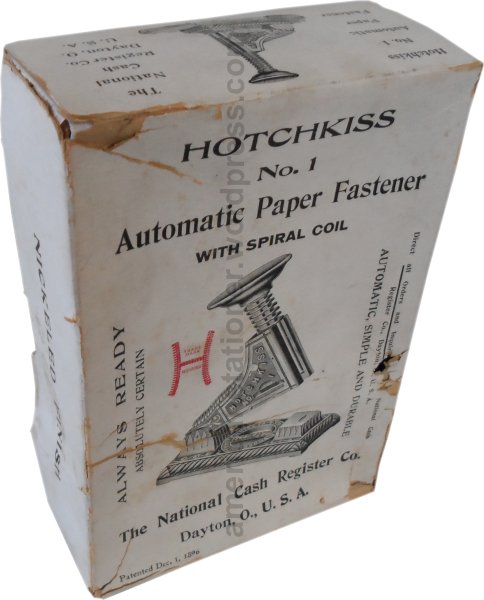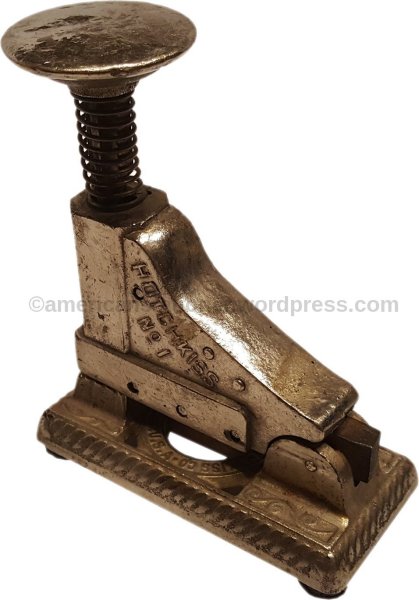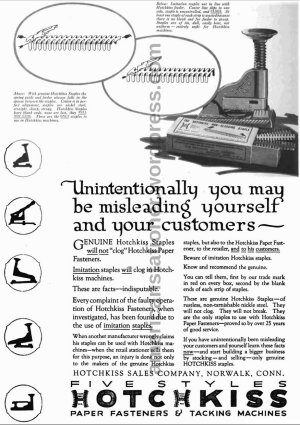The E.H. Hotchkiss Company was started in 1897 when, several years after first investing in the company, Eli Hotchkiss gained control of the Jones Manufacturing Company. The Jones Manufacturing Company had been producing a stapling machine since 1895 known as the Star Paper Fastener. The Star Paper Fastener is the direct antecedent of the Hotchkiss No. 1. In 1901, after some design changes, the Star Paper Fastener was released as the Hotchkiss No. 1.
There were three different primary versions of the Hotchkiss No. 1 during the time it was available (see note 11). And each version came in two styles; with a staple-holding spiral coil (aka “tail”) and without.
The first version of the Hotchkiss No. 1 was introduced in 1901 and was available at least through 1921 and probably a bit longer. The picture above is of a first version without a spiral coil while the picture at the beginning of the post shows a first version with a spiral coil. A first version without a spiral coil weighed 1 pound 2 ounces and was made of nickel-plated cast iron. It measured 4″L x 2″W x 4.5″H.


Every once in a while you may see a No 1 with a circular hole in the side (see above). This is a factory repaired fastener. These early No 1 fasteners were very difficult to take apart for repair and it was sometimes easier to access the interior workings by drilling a hole in the side. And since Hotchkiss did guaranty their fasteners you’ll see these from time-to-time.

let’s call this version 2a
This version is something of a mystery. My initial reaction on seeing it is that it was a pre-production model or possibly a prototype. There are versions both with and without a spiral coil. Also, the model in the picture above has the NCR stamped plunger which implies it was available through them. However, I’ve never found any ads or catalog listings for this particular version. Further, the quality of the zinc used in the body was abysmal and it was coupled with a squared design that tended to cause stress cracks on different parts of the stapler body. My opinion is that this was the precursor to the version 2 (shown next) and that it had limited availability and was never advertised. As the version 2 below was advertised in 1920, again this is my opinion, I believe that this model was available about 1919. Note that the version 2 below has a more rounded front and this would have added greater strength compared to this version. (see note 12)

The second version of the No. 1 was introduced about 1920 and was available at least until 1921. It is possible that it was available a year or two before or after this time period but I cannot verify that at this time. However, it should be noted that due to the popularity and longevity of this stapler there was some overlap in the selling of the different versions of the No. 1 and it wasn’t unusual for stationer A to offer the first version for sale while stationer B offered the newer version. This weighed 1 pound 2 ounces and measured 3.875″ L x 1.938″ W x 4.438″ H. The body material was changed from iron to “nickel-plate diecast” metal. There were a number of improvements introduced with this version which was likely a response to the growing competition Hotchkiss had in the field of strip staplers. Observe also the design changes made to this version. It did keep the same style base, only enameled in black, the body shape changed slightly but most noticeably, again except for the base, all additional ornamentation has been removed for a much smoother and cleaner look. It is my belief that the introduction of the Greenfield Fastening Machine is the inspiration of both many of the mechanical improvements and also of the design changes.

The third version of the No. 1 was introduced in 1921. It was sold by stationers at least until 1946 but was likely available for a long-time afterwards. This weighed 1 pound 2 ounces and measured 3.875″ L x 1.938″ W x 4.188″ H. Also, while the plunger, anvil, and some of the internal parts were made of steel, the remainder of the stapler was made from “nickel-plate diecast”. Note the absence of details such as what type of diecast metal. All I can tell you is that the diecast is non-ferrous (not iron, steel, or any kind of magnetic metal). Again this model was introduced with some fanfare as an improved model which seemed to mainly consist of some kind of special staple straightener and guide which prevented clogs.

Models of the third version introduced between 1921 and 1924 had a base with the H logo pierced. It will also state Patent Pending above the logo but nothing else. Let’s call this version 3a. For third version models introduced 1925 until about approximately 1930 there is now a line stating “PAT JAN 20, 1925.” and underneath “OTHERS PENDING”. We can call this version 3b. In the early 1930’s we now have a solid base and while the logo will be the same the base will not be pierced. These will also have a patent date along with the words “others pending”. We’ll call this version 3c.


later version of Hotchkiss No 1 in black crackle finish available in 1940’s
The No. 1 was one of the first staplers to use a strip of staples. A staple-strip looks similar to today’s magazine staples. But whereas today’s staples are individual metal U-shaped fasteners individually manufactured and glued together into the strips you use currently, a staple-strip was actually formed and cut from a single piece of metal. When you pressed down on the plunger it cut the staple from the strip as opposed to simply separating it from the magazine strip. This necessitated a certain amount of force that today would be considered excessive. As a matter of fact, it was not unheard of when these were popular for office workers to have a rubber mallet nearby to use with this. That being said, my experience is that while these take more effort to use I’ve never had to resort to that kind of an extreme.

Staples for the Hotchkiss No. 1 are no longer made. However, if the mechanisms work then you can be confident that you have a working stapler. If you do find staples, I recommend caution in using them in your antique stapler. As I’ve mentioned before, old iron gets brittle and while you’ll probably be ok using your stapler once or twice it likely will not be able to stand up to regular use. Furthermore, unjamming one of these No. 1’s is extremely difficult to near impossible so if you do use it (even once) ensure that you use Hotchkiss staples. Other brands might have claimed to work in the No. 1 but keep in mind that items such as this were not made to the same exacting tolerances you’ve come to expect today so the likelihood of issues is greatly increased with off-brands.
The Hotchkiss No. 1 was sold for over 40 years making this probably the easiest antique stapler to find and add to your collection. It was successful enough to spawn a number of European manufactured clones and even gave its name to the Japanese language as the word for stapler (hotchikisu).
Want to know more about Hotchkiss fasteners and history? Purchase Staplers, Stapling Machines, & Paper Fasteners Volume 1: Illustrating and Documenting the Hotchkiss Line of Office and Industrial Stapling Machines by American Stationer and available on Amazon.
Patent & Other Information:
- Directions for using Hotchkiss No 1 Machine (v1)
- US Patent 572293 (v1) filed 11/16/1894 granted 12/01/1896
- US Patent 1480163 (v2) filed 01/17/1920 granted 01/08/1924
- US Patent 1502346 (v3) filed 11/10/1921 granted 07/22/1924
- US Patent 1523837 (v3) filed 12/18/1922 granted 01/20/1925
Notes:
- Editors (1897, November). Trade Items. The American Stationer, page 734
- Reynolds Bros. (1901, July). advertisement. Scranton Tribune, page 5
- Editors (1903, October). The Story of the Man Who Made the Star Stapler Famous. The Book-Keeper The Business Man’s Magazine, pages 178-180
- F.P. Burnap Stationery and Printing Co Catalog (1915), Kansas City, MO page 111
- Hotchkiss Sales Co. (1920, December). advertisement. System the Magazine of Business, page 1121
- Editors (1921, November). New Member of the Hotchkiss Family. Walden’s Stationer and Printer, page 78
- Bunshodo Corporation catalog (1922, July), Tokyo, Japan page 45
- Editors (1922, September). Improvement of Hotchkiss Paper Fastener. The American Stationer and Office Outfitter, page 26
- Editors (1922, September). Hotchkiss Fasteners Now Have Straightener. Office Appliances, page 39
- The Brief Catalog (1938), Kansas City, MO page 17
- Utility Office Supply Catalog (1946), Chicago, IL page 387
- It had been brought to my attention that another collector was talking about a another version of the No 1 which I’ve labeled above as version 2a. He has stated that the reason it is so rare is that Hotchkiss was “embarrassed” by it. It is unlikely that it is so rare because Hotchkiss was embarrassed. More likely Hotchkiss took swift action to get these off of store shelves as soon as they discovered that it had some major quality shortcomings. Anyway, as soon as this heretofore unknown model was brought to my attention I started reaching out to fellow enthusiasts, antique shops, etc. in an effort to procure one of these. It took a bit over 6 months but I was able to find one, albeit in a pretty poor state, for under $30. For me, its real value is in how it fills in some blanks in the evolution of the No 1 Stapler. Information is practically non-existent for this model but I’ll stay the course looking for whatever I can find out.
- In January 2019 I was contacted by a reader who stated that he had a version 3 of the Hotchkiss No 1 that didn’t quite conform to any of the variants I had written about here. Well, after some back and forth it turns out he had indeed discovered a new variant! This new variant I’ve labeled as version 3b. Above you’ll see a photo showing the underside of the base of all three variants of version 3. The photo of the underside of the base labeled version 3b is from David Billo who hails from the great white North. Good job David and thanks for expanding our knowledge of this fastener!
- Below is a picture of a Hotchkiss No. 1A stapler (note the front of the base). This is a totally different stapler from the Hotchkiss No. 1. I’ve had more conversations with folks who thought I was talking about the below pictured stapler when in reality I was talking about the above models. You might be wondering why in the world didn’t they use a different numbering system for a different stapler. Unfortunately, the answer is; nobody knows.
Visit me at http://www.facebook.com/americanstationer.















How interesting to find this stapler. I have had a Hotchkiss No 2 stapler laying around in a desk drawer for as long as I can remember (I’m 74). It was my parents. My curiosity got the better of me, and I found your web side. My Hotchkiss is the same shape but not as decorative —- very plain. Stamped lettering on the bottom reads PAT. JAN. 20: 1925 OTHERS PENDING. Underneath the stapling part Is a large red H with a circle around it and the lettering .THE E,H, HOTCHKISS CO. NORWALK CONN. U.S.A Thanks for the very Interesting story about it.
Nancy
LikeLike
Where can you get hold of the staple strips?
LikeLike
They are no longer commercially available. You will need to look at estate sales, antique stores, online auctions and such
LikeLike
After reading your review of the Hotchkiss no.1 stapler, I gave mine a clause look. It is the same as shown with our a tail and has a patent date of Dec 1, 1896. I also have the original box for the staples with 3 full strips. Thank you for your interesting review.
Chuck
LikeLike
I would be most thankful if you could share pictures of the strips and the box. Thank you!
LikeLike
I have a couple of these delightful pieces in my collection and would be very interested in finding some staple strips. I appreciate any help in finding some!
LikeLike
Staples for this machine are no longer made. The only way you may find some is by trolling around estate sales, flea markets, auctions, etc.
LikeLike
Pingback: Hotchkiss No. 1 Stapler – Part 2 | American Stationer
I presently work in a second-hand retail store situated in the
Norwalk CT 10 Hoyt St building originally occupied by Vanderbilt
Chemical Corp, and before that – Hotchkiss Sales Company,
makers of the Hotchkiss Paper Fastener – known today simply
as “staplers”. Our store front faces Cross Street(US-1), but the
original front of the building we occupy still looks as it did nearly
a century ago! Many of our neighbors are of the four-legged
variety. 🙂
LikeLike
I have a hand-held Hotchkiss bearing the label THE HOTCHKISS SALES CO.which
may have been used by my father as early as the mid-’20s. It is marked as having
a USA patent,, and MADE IN GERMANY. I recall my father using it in the late ’40’s, but when I attempted to locate staples for it about 2000, local dealers had nothing to offer – neither information nor staples. It looks, and feels as though it would still be usable–if it had staples.
Any information would be appreciated.
LikeLike
You didn’t give enough info for me to help you. It may be a model 52 or 54 but no way to know. Email me through the Contact page and I’ll try to help.
LikeLike
Pingback: Ideal Clipless Paper Fastener | American Stationer
Hi I found a model of a 1A on the bottom it reads The EM Hotchkiss Co Norwalk Conn made in USA patent pending and no date
LikeLike
Just for clarification, since I tried to find out why the Japanese word for stapler is “hotchkiss” – “The Hotchkiss” was a specific kind of stapler that isn’t produced anymore?
LikeLike
Hotchkiss was actually a brand of staplers, like Swingline, Bostitch, etc. The Hotchkiss No 1 was a specific stapler and was the first stapler ever imported into Japan. Because it was the first, there was no native Japanese word for “stapler” and they simply ended-up calling all staplers a “Hotchkiss”. This is in much the same vein as when you ask someone for a Kleenex or for some Scotch tape.
LikeLike
Thank you AmericanStationer for clearing that up! For goodness sakes Hotchkiss sounds about as Japanese a name as Mackenzie. It’s an old English surname.
LikeLiked by 1 person
Scotch tape is also a name of a brand of PSA tape.
LikeLike
Hi there!
I have the Hotchkiss plier model from mid-century and can’t find #53 staples. Do you have any ideas on where to get them? I measured them and they seem to be 7/16″ x 1/4″.
LikeLike
I would first need to check to see if there are other staplers still made that use that size. However, assuming there isn’t you can try Staplex at http://www.staplex.com/staplers/equalto.htm. If they don’t have them in stock they can probably manufacture them for you.
LikeLike
PLEASE, WHERE I COULD TO BUY A ANTIQUE STAPLES BOX FOR HOTCHKISS Nº 1 STAPLER.
LikeLike
A commonly asked question. Please see the previous comments.
LikeLike
Pingback: Classic Item in the Calhoun County Museum | Jazzersten's HDR Blog
“Models of the third version introduced between 1921 and 1924 had a base with the H logo pierced. It will also state Patent Pending. For third version models introduced after 1924 it will have a solid base and while the logo will be the same the base will not be pierced. These will also have a patent date along with the words “others pending”.
I have a No1 with the 1925 patent date and “others pending”, but it also has the pierced H logo.
LikeLiked by 1 person
I sent you a separate email about your potential new variant. Very exciting!
LikeLike
I got a “Confrim follow” email…that’s it.
LikeLike
Maybe I ran foul of your spam filter or something. Would you be ok with emailing me through the “Contact Me” page?
LikeLike
OK, I logged in with my wordpress credentials, so there is an alternate gmail address that might work.
LikeLike
Found this site searching for info on a catalog printing “cut” (aka plate) which I found in an antique shop. It shows a #1, 3rd version as photographed above. On the round plate beneath the body I can see “Norwalk” but no state named, perhaps because the badge goes underneath the body. I plan to print this cut; hopefully it will turn out well enough to share with you. Glad you have collected so much information on this interesting and different stapler.
LikeLike
Pingback: Jones Star Paper Fastener | American Stationer